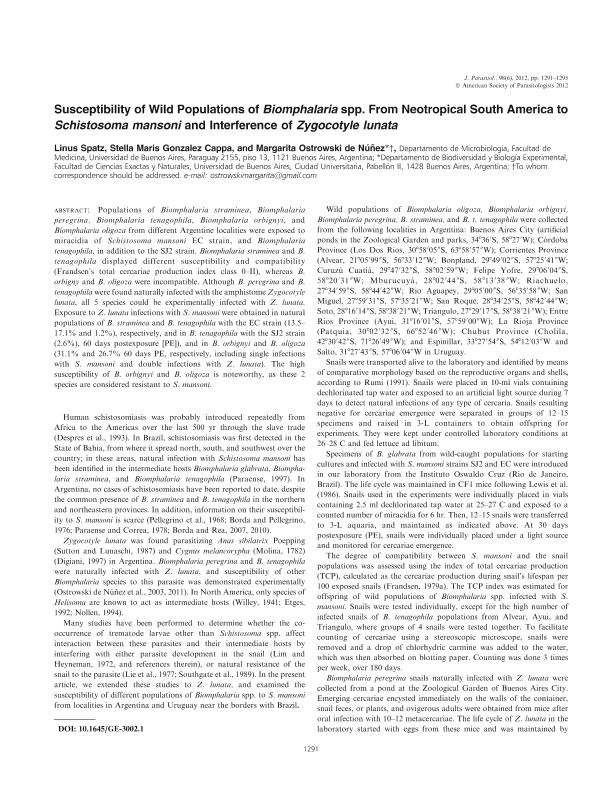Artículo
Susceptibility of wild populations of biomphalaria spp. from neotropical South America to schistosoma mansoni and interference of zygocotyle lunata
Fecha de publicación:
12/2012
Editorial:
American Society of Parasitologists
Revista:
Journal of Parasitology
ISSN:
0022-3395
Idioma:
Inglés
Tipo de recurso:
Artículo publicado
Clasificación temática:
Resumen
Populations of Biomphalaria straminea, Biomphalaria peregrina, Biomphalaria tenagophila, Biomphalaria orbignyi, and Biomphalaria oligoza from different Argentine localities were exposed to miracidia of Schistosoma mansoni EC strain, and Biomphalaria tenagophila, in addition to the SJ2 strain. Biomphalaria straminea and B. tenagophila displayed different susceptibility and compatibility (Frandsen's total cercariae production index class 0-II), whereas B. orbigny and B. oligoza were incompatible. Although B. peregrina and B. tenagophila were found naturally infected with the amphistome Zygocotyle lunata, all 5 species could be experimentally infected with Z. lunata. Exposure to Z. lunata infections with S. mansoni were obtained in natural populations of B. straminea and B. tenagophila with the EC strain (13.5-17.1% and 1.2%), respectively, and in B. tenagophila with the SJ2 strain (2.6%), 60 days postexposure [PE]), and in B. orbignyi and B. oligoza (31.1% and 26.7% 60 days PE, respectively, including single infections with S. mansoni and double infections with Z. lunata). The high susceptibility of B. orbignyi and B. oligoza is noteworthy, as these 2 species are considered resistant to S. mansoni.
Archivos asociados
Licencia
Identificadores
Colecciones
Articulos(IMPAM)
Articulos de INSTITUTO DE INVESTIGACIONES EN MICROBIOLOGIA Y PARASITOLOGIA MEDICA
Articulos de INSTITUTO DE INVESTIGACIONES EN MICROBIOLOGIA Y PARASITOLOGIA MEDICA
Citación
Spatz, Linus; González, Stella Maris; Ostrowski, Margarita Clotilde; Susceptibility of wild populations of biomphalaria spp. from neotropical South America to schistosoma mansoni and interference of zygocotyle lunata; American Society of Parasitologists; Journal of Parasitology; 98; 6; 12-2012; 1291-1295
Compartir
Altmétricas




